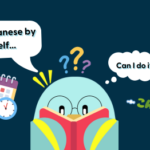Understanding the Difference Between “止まる” (Tomaru) and “止める” (Tomeru) Made Easy
The difference between “止まる” (tomaru) and “止める” (tomeru) can be confusing. Let’s explain it simply! How should you use each one? Both seem to mean “something stops,” but what makes them different?
Both “止まる” (tomaru) and “止める” (tomeru) describe the action of stopping, but they are used in different contexts. Today, Eri-san from JPLT Online Japanese Language School will explain these differences in a simple way for Japanese learners.
■ What is “止まる” (tomaru)?
“止まる” (tomaru) is an intransitive verb that describes something stopping on its own.
- The subject acts on its own: The subject itself stops without an external force.
- Natural stopping: It happens as part of a natural process.
Examples:
- 車が止まる (kuruma ga tomaru): The car stops (e.g., the car’s engine turns off by itself).
- 雨が止まる (ame ga tomaru): The rain stops (e.g., the clouds dissipate, and it stops raining).
- 時計が止まる (tokei ga tomaru): The clock stops (e.g., the battery runs out, and the hands stop moving).
■ What is “止める” (tomeru)?
“止める” (tomeru) is a transitive verb that describes stopping something else.
- Acting on others: It involves taking action to stop someone or something.
- Intentional action: It implies deliberate or forced stopping.
Examples:
- 車を止める (kuruma o tomeru): The driver stops the car (e.g., by stepping on the brake).
- 音楽を止める (ongaku o tomeru): Stop the music (e.g., using a remote control).
- 友達の話を止める (tomodachi no hanashi o tomeru): Stop a friend’s conversation (e.g., interrupting to change the topic).
■ Summary: The Difference Between “止まる” (tomaru) and “止める” (tomeru)
Word | Characteristics | Usage |
|---|---|---|
止まる (tomaru) | Intransitive verb | Used when something stops naturally, the subject stops itself. |
止める (tomeru) | Transitive verb | Used when stopping something intentionally, acting on others. |
■ Which Should You Use?
It depends on what you’re trying to express and the situation:
- Use “止まる” (tomaru) when something stops on its own.
- Use “止める” (tomeru) when someone intentionally stops something.
■ Summary
How to Distinguish Between “止まる” (tomaru) and “止める” (tomeru)
Although “止まる” (tomaru) and “止める” (tomeru) may seem similar, they actually convey different nuances. “止まる” (tomaru) is an intransitive verb indicating that something stops on its own or as part of a natural process. On the other hand, “止める” (tomeru) is a transitive verb that means stopping something else intentionally.
For example, “雨が止まる (ame ga tomaru)” means that the rain naturally stops, while “車を止める (kuruma o tomeru)” means that the driver intentionally stops the car. Even though they both involve “stopping,” the choice of word depends on the context.
In Japanese, there are many such words that seem similar but have subtle differences in meaning. By exploring each word deeply, you can better understand the richness of the Japanese language and learn how to express yourself more clearly.
Want to Learn More?
If you’re interested in learning more about Japanese words and want to deepen your knowledge, visit JPLT Online Japanese School. It’s an online community where people from around the world come together to learn Japanese for free.
From Japanese Language Proficiency Test (JLPT) preparation to practicing everyday conversation, we offer a wide range of courses. Just like the words “止まる” (tomaru) and “止める” (tomeru), the Japanese language is full of new discoveries. But don’t worry—our courses are designed to guide you through each new step.




